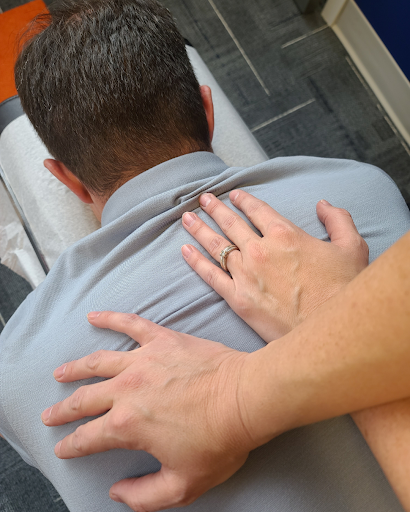Back pain is a prevalent ailment influenced by various factors, including poor posture, muscle overexertion, and physical injuries. It manifests in multiple forms, each distinguished by its symptoms and underlying causes.
Acute back pain, one of the most frequent types, emerges suddenly, often due to injury or muscle strain. It generally resolves within days to weeks. However, some individuals may endure chronic acute back pain, persisting for months or even years. Chronic back pain, another widespread type, typically stems from persistent conditions such as arthritis or herniated discs. The intensity of chronic back pain can fluctuate, and it may periodically wax and wane.
Consulting a chiropractor is crucial for those suffering from back pain, as identifying the root cause is the first step towards recovery. With appropriate diagnosis and treatment, many can alleviate their back pain and resume their daily activities.
What Causes Back Pain?
Back pain, a prevalent health issue, arises from a myriad of causes, ranging from everyday habits to more serious conditions. It may stem from structural issues, injuries, or diseases affecting the spinal region.
Strains and Sprains:
The leading cause of back pain is often a strain or sprain, resulting from overexertion or improper lifting techniques. These injuries can affect muscles, tendons, and ligaments, especially after prolonged activity without adequate rest. Sprains involve stretching or tearing of ligaments, often occurring during physical activity or accidents, leading to significant discomfort and bruising.
Fractures:
Spinal fractures can occur from traumatic events such as car accidents or falls. Conditions like spondylosis and osteoporosis heighten fracture risks by weakening the bones, making them more susceptible to breaks.
Disk Issues:
Spinal disks act as cushions between the vertebrae. These disks can bulge or herniate, pressing on nerves, or undergo degenerative changes over time, leading to pain and reduced protection against injuries.
Structural Problems:
Spinal structure issues, such as narrowed disks or scoliosis, can compress nerves, causing pain in the lower back or radiating pain along nerves, notably in conditions like sciatica.
Arthritis:
Osteoarthritis and ankylosing spondylitis are common arthritis forms affecting the lower back, leading to inflammation, stiffness, and pain in the spinal region.
Diseases:
Various diseases, including kidney stones, abdominal aortic aneurysms, spine tumors, or infections, can manifest as back pain, highlighting the diverse potential causes behind this condition.
Spondylolisthesis:
This condition involves the misalignment of vertebrae, leading to lower back pain that may extend down the leg. It results from the slipping of one vertebra over another, potentially causing nerve damage or spinal cord compression.
Understanding the specific cause of back pain is crucial for effective treatment, underscoring the importance of medical consultation for diagnosis and management.
5 Types of Back Pain in Centennial
1. Flexion Dominant Back Pain
Flexion Dominant Back Pain is a prevalent condition affecting numerous individuals, significantly influencing their daily lives. This type of back pain is primarily aggravated by activities such as sitting, bending, and lifting, while symptoms often ameliorate upon standing or walking for brief periods. It can manifest as pain in the spine, legs, or both, sometimes accompanied by tingling, numbness, and even leg weakness. Additionally, individuals may experience pain during coughing or sneezing and a noticeable reduction in their ability to straighten up after sitting. Treatment typically involves a regimen of stretching, strengthening exercises, and massage, with more severe cases requiring injections or surgery. Nonetheless, many find relief through conservative treatment methods.
2. Extension Dominant Back Pain
Extension Dominant Back Pain, caused by factors such as poor posture, weak back muscles, and tight hamstrings, is another common back issue. Effective treatment strategies include hamstring stretching and back muscle strengthening. Symptoms include discomfort after prolonged standing and relief upon sitting or bending. Unlike flexion-dominant back pain, the range of motion remains consistent, though stiffness is a constant feature. Pain might also escalate following high-impact activities, with symptoms potentially extending to localized spinal discomfort and, in severe instances, leg pain or numbness. Maintaining proper posture and minimizing prolonged sitting or standing are key preventive measures.
3. Neurogenic Claudication
Neurogenic Claudication arises from nerve compression in the spine, attributed to conditions like herniated discs, degenerative disc disease, spinal stenosis, and spondylolisthesis. Characteristically, patients experience no symptoms while seated but develop leg pain, numbness, or weakness after walking a certain distance. Interestingly, spine pain may not be present. Symptoms alleviate when the patient sits or leans forward, as seen in individuals leaning on a shopping cart for pain-free walking.
4. Inflammatory Back Pain
Inflammatory Back Pain leads to discomfort and cramping in the legs, often stemming from degenerative spinal changes such as herniated discs or spinal stenosis. Chiropractic adjustments can be particularly beneficial, potentially relieving nerve pressure and enhancing circulation. This condition typically affects individuals under 35, not related to trauma, with symptoms persisting beyond three months. Pain and stiffness worsen with inactivity, especially at night and early morning, but improve with physical activity.
5. Chronic Pain Disorders
Chronic Pain Disorders encompass conditions causing persistent pain due to various factors, including injuries, diseases, and nerve damage, significantly impacting one’s quality of life. Symptoms and pain locations can vary significantly, often not confined to anatomical boundaries and may shift to different body parts. Furthermore, psychological factors like anxiety or depression can exacerbate the pain, which doesn’t always correlate directly with physical trauma or stress.
What are the Risk Factors of Back Pain?
Back pain is a widespread issue that spans across various age groups, though it predominantly affects individuals as they age, attributed to the natural degeneration and wear our bodies undergo.
Key risk factors contributing to back pain encompass:
- Occupational Activities: Jobs that demand heavy lifting, prolonged standing, or repetitive motions can significantly heighten the risk of developing back pain.
- Pregnancy: The additional weight and stress on the spine during pregnancy often lead to discomfort and back pain.
- Poor Physical Fitness: Weak back and abdominal muscles may not adequately support the spine, increasing vulnerability to back pain.
- Sedentary Lifestyle: Lack of regular activity contributes to poor posture and weakened spine support muscles, elevating the risk of back pain.
- Obesity or Excess Weight: Extra weight puts additional pressure on the spine and joints, leading to increased chances of back pain.
- Smoking: Smoking can reduce blood flow to the spine, impede healing, and increase the risk of degenerative spinal disorders.
- Strenuous Physical Exercise or Work: Engaging in high-impact sports or physical labor without proper form or preparation can lead to back injuries.
- Genetic Factors: A predisposition to certain conditions like degenerative disc disease can be inherited, increasing the risk of back pain.
- Medical Conditions: Diseases such as arthritis and cancer can directly affect the spine or create conditions that exacerbate back pain.
Understanding and mitigating these risk factors can help in preventing or alleviating back pain, highlighting the importance of maintaining a healthy lifestyle and seeking appropriate medical advice for persistent symptoms.
Chiropractic Care for Back Pain in Centennial
Back pain is a prevalent issue, affecting one in four individuals at some stage in their lives. In Centennial, chiropractic care stands out as a valuable approach for managing back pain. This non-invasive treatment method focuses on manual adjustment and manipulation of the spine to improve alignment, relieve pain, and enhance overall bodily function. Chiropractors are skilled in diagnosing and treating back pain, offering personalized care plans that may include exercises, lifestyle advice, and other non-surgical treatments aimed at promoting spinal health and preventing future episodes of back pain. Through chiropractic care, many individuals experience significant improvements in pain levels and mobility, making it a sought-after option for those seeking relief from back pain and an enhanced quality of life. At Campbell Chiropractic in Centennial, experts use a variety of techniques to treat back pain, including spinal adjustments, and exercise therapy.
If you’re exploring alternatives to conventional medical treatments for your health concerns, consider, chiropractic care in Centennial may be the right choice for you. Book an appointment today or call us at (720) 708-2275.




